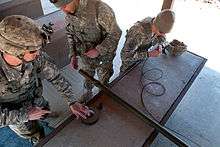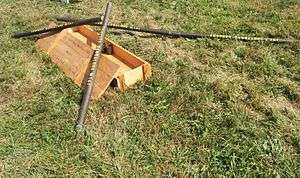Bangalore torpedo
| Bangalore torpedo | |
|---|---|
 | |
| Place of origin | Bangalore, India |
| Service history | |
| In service | 1914–present |
| Used by | Indian Army, Pakistani Army, British Army, Canadian Army, United States Army, Peoples Liberation Army (China), Finnish Defense Forces, Philippine Army, Philippine Constabulary, Philippine Marine Corps |
| Wars | World War I, World War II, Korean War |
| Production history | |
| Designer | Captain McClintock |
| Designed | 1912 |
| Specifications | |
| Length | up to 15 m (49 ft) in 1.5 m (4.9 ft) sections |
|
| |
| Filling | TNT, C4 |
A Bangalore torpedo is an explosive charge placed within one or several connected tubes. It is used by combat engineers to clear obstacles that would otherwise require them to approach directly, possibly under fire. It is sometimes colloquially referred to as a "Bangalore mine", "banger" or simply "Bangalore".
Per United States Army Field Manual 5-250 section 1-14, page 1-12 "b. Use. The primary use of the torpedo is clearing paths through wire obstacles and heavy undergrowth. It will clear a 3- to 4-metre wide path through wire obstacles."
Overview

The Bangalore torpedo was first devised by Captain R. L. McClintock,[1] of the Royal Engineers while attached to the Madras Sappers and Miners unit of the Indian Army at Bangalore, India, in 1912. He invented it as a means of exploding booby traps and barricades left over from the Boer War and the Russo-Japanese War.[2] The Bangalore torpedo could be exploded over a mine without a sapper having to approach closer than about 3 m (10 ft).
Bangalore torpedoes are currently manufactured by Mondial Defence Systems of Poole, UK,[3] for the UK and US armed forces. They have been used recently in operations in Afghanistan for actions such as clearing enemy supply dumps within deep cave systems.
In World War I
By the time of World War I the Bangalore torpedo was primarily used for clearing barbed wire before an attack. It could be used while under fire, from a protected position in a trench. The torpedo was standardized to consist of a number of externally identical 1.5 m (5 ft) lengths of threaded pipe, one of which contained the explosive charge. The pipes would be screwed together using connecting sleeves to make a longer pipe of the required length, somewhat like a chimney brush or drain clearing rod.
A smooth nose cone would be screwed on the end to prevent snagging on the ground. It would then be pushed forward from a protected position and detonated, to clear a 1.5 m (5 ft) wide hole through barbed wire. During the 1917 Battle of Cambrai, British Royal Engineers used them as diversions to distract the enemy from where the real battle was to be fought.[4]
In World War II
 Four pieces of an M1A1 Bangalore torpedo: two individual pieces, and two attached together. Note the misspelled stenciling on the tubes | |
| Place of origin | United States |
| Service history | |
| Wars | World War II |
| Production history | |
| Produced | February 1943-November 1944 |
| No. built | Approximately 3,255,000 torpedo sections |
| Specifications (Torpedo, Bangalore, M1A1) | |
| Weight | 13 lb (5.9 kg) per torpedo section |
| Length | 5 ft (1.5 m) |
| Diameter | 2.125 in (54.0 mm) |
|
| |
| Filling | TNT and 80-20 TNT and ammonium nitrate |
| Filling weight | 9 lb (4.1 kg) per torpedo section |
Detonation mechanism | Blasting cap (standard) |
| References | Catalogue of Standard Ordnance Items, Second Edition 1944 Volume III, p. 598 |
The Bangalore torpedo was reportedly used in the British offensive on Bardia during the Western Desert Campaign, on 3 January 1941.[5]
The Bangalore torpedo was later adopted by the U.S. Army during World War II, as the "M1A1 Bangalore torpedo". Bangalore torpedoes were packed in wooden crates that contained 10 torpedo sections, 10 connecting sleeves, and 1 nose sleeve; the total weight of a crate was 176 pounds (80 kg). Each torpedo section was 5 feet (1.5 m) long, 2.125 inches (54 mm) in diameter, and weighed 13 pounds (5.9 kg). Each end of the torpedo was filled with 4 inches (102 mm) of TNT booster, while the middle section contained an 80-20 amatol mixture; the explosive charge weighed about 9 pounds (4.1 kg). Each end of the torpedo had a recess to accommodate a standard Corps of Engineers blasting cap. Torpedo sections could be attached together via spring clip-equipped connecting sleeves, and a blunt nose sleeve was provided so that the assembled torpedoes could be pushed through obstacles or across terrain without getting stuck.
It was widely used by the U.S. Army, notably during the D-Day landings. The Bangalore torpedo was obsolete in British use at the time of D-Day, having been replaced by rocket-launched Congers and Armoured Vehicle Royal Engineers (AVRE) vehicles equipped with a 40-pound (18 kg) explosive charge for bunker clearing.
Post-World War II development
The Bangalore continues to be used today in the little-changed M1A2 version, primarily to breach wire obstacles. Combat engineers have also been known to construct similar field versions of the Bangalore by assembling segments of metal picket posts and filling the concave portion with plastic explosive. The PE is then primed with detonating cord and a detonator, and pickets are taped or wired together to make a long torpedo, producing fragments (aka "shrapnel") that cut the wire when detonated. This method produces results similar to the standard-issue Bangalore, and can be assembled to the desired length by adding picket segments.
During the Yom Kippur War in 1973, Bangalore torpedoes were used by the Israelis to clear paths through Syrian minefields.[6]
The newest evolution of the Bangalore is the Bangalore Blade, an updated version made from lightweight aluminium and using explosively formed penetrator technology to breach obstacles which the original Bangalore would have been unable to defeat. In a test detonation conducted on the television show Future Weapons, the Bangalore Blade blasted a gap roughly five meters wide in concertina wire, and created a trench deep enough to detonate most nearby anti-personnel mines. The Bangalore Blade was developed in the United Kingdom by Alford Technologies.
Other recent path-clearing devices
The U.S. anti-personnel obstacle breaching system (APOBS) and the British RAMBS II rifle grenade breaching system are starting to replace the Bangalore for path-clearing due to their ease of use, effectiveness, and flexibility—they can clear a path several times longer than the Bangalore torpedo.
See also
References
- ↑ Note; later Lieutenant-Colonel R. L. McClintock, C.M.G., D.S.O., R.E.
- ↑ Duffy, Michael. "Bangalore Torpedo". www.firstworldwar.com. Retrieved 26 July 2013.
- ↑ "Bangalore Torpedo – 8x1m Tube Set". Mondial Defence Systems, Poole, UK. Retrieved 2013-05-11.
- ↑ Wilfrid Miles, Official History of the Great War, Military operations, France and Belgium 1917, Volume III, The Imperial War Museum Department of Printed Books (1948), pp.96
- ↑ History of the Second World War, the Mediterranean and Middle East vol 1 Publisher HSMO 1954
- ↑ Rabinovich, Abraham. The Yom Kippur War. Schoken Books (2005), p309
External links
- Bangalore Torpedoes February 1944 Popular Science World War II article
- Future Weapons: Bangalore Blade (video)